Some of you may be familiar with my diaries about the Village Bottoms neighborhood in West Oakland and the African American community’s struggles and efforts to rise from the ashes of urban blight. I’ve been drawn to this story not only because it engenders much of the social, environmental and racial injustices of urban planning in the U.S., but because it offers that rare glimmer of hope where hardened stereotypes and institutionalized injustices might be overcome by individuals and communities committed to breaking these cycles that keep everything the same as it ever was.
Unfortunately, it looks as if one incident — a fraudulent email allegedly sent by Marcel Diallo, one of the leading figures in the struggle to rebuild and revive a once vibrant black neighborhood — is being used to discredit the efforts and achievements of a community that has served as an example of how to use creativity, collaboration, and a strong sense of roots to compensate for the lack of money and power in building a just and sustainable city.
Let me start out with a brief recap of my involvement with the Village Bottoms community. This summer I began to volunteer for Ecocity Builders, a non-profit organization that I have admired since its inception in 1992 for their work to transform cities into more walkable, bikable and livable entities, long before climate change became a household name. 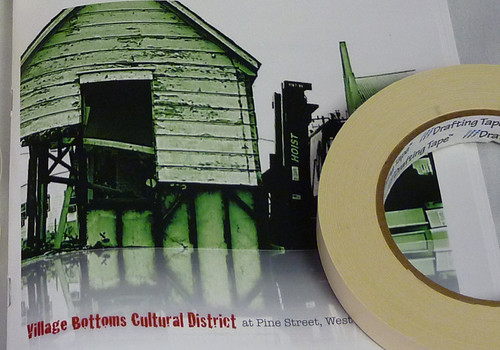 My first project was to do the historical research for a plan that Ecocity Builders was developing in conjunction with the Village Bottoms Neighborhood Association to establish an African American Cultural District based on ecocity principles, combining the community’s deep roots, enthusiasm and vision with EB’s experience and track record in creating higher density, walkable, centers-oriented development. The 60 page booklet is now available in its full version and a good portion of it can be viewed here.
My first project was to do the historical research for a plan that Ecocity Builders was developing in conjunction with the Village Bottoms Neighborhood Association to establish an African American Cultural District based on ecocity principles, combining the community’s deep roots, enthusiasm and vision with EB’s experience and track record in creating higher density, walkable, centers-oriented development. The 60 page booklet is now available in its full version and a good portion of it can be viewed here.
Reading books like American Babylon – Race and the Struggle for Postwar Oakland by Robert O. Self or No There There – Race, Class, and Political Community in Oakland by Chris Rhomberg, I was struck by how devastating the “urban renewal” movement of the last century had been to a once thriving African American city district, and that the urban flight of a mostly white middle and upper class wasn’t just a random occurrence but the result of very deliberate planning decisions keeping a poor, mostly black working class isolated not only physically from important services but intellectually from the centers of political power and influence. I wrote about this history in Ecocities: From the Bottoms Up. Next, I got to witness about 25 members of the community collaborate with a group of architects, designers and urban planners at the West Coast Green Conference, as reported in Village Bottoms, Vol. 2: Don’t save us, work with us! A couple of weeks later I had an inspiring visit and tour of the Black Dot Cafe, Soul Food Coop, and Village Bottoms Farm, which I documented in the photo essay Village Bottoms, Vol. 3: Getting a taste of what it means to be Black.
I’m saying all this because the article I’m about to discuss doesn’t mention any of it, and I strongly believe that in order to fairly judge a man, a situation, or an entire community, one must provide as broad a context as possible. If a charge leveled against a man is supported by a wholesale assault on his character based on a slew of incomplete, untrue or irrelevant information, and if this charge is used to discredit the entire value of the man’s and his community’s work, it would seem reasonable to allow the other side(s) of the story to be heard before arriving at a judgment. This is what I will attempt to do here. You be the judge.
Last week, the East Bay Express, the only major weekly paper covering Oakland and the East Bay, published an article entitled You Don’t Know Jack by Robert Gammon. The first part of the article covers the charge alluded to above, brought to the author’s attention by the plaintiff, Max Allstadt:
Oakland activist and political blogger Max Allstadt was the victim of a vicious Internet fraud that could have happened to anyone. A scam artist set up a fake e-mail account, disguised as Allstadt, and then sent out an ugly e-mail full of racist and homophobic invective. Allstadt was stunned, but decided to fight back, and through a series of court-ordered subpoenas, he uncovered strong evidence that the person behind the fraudulent e-mail was Marcel Diallo, a well-known black-empowerment activist and self-styled “mayor of West Oakland” who was featured earlier this year on CNN.
The strong evidence comes from a subpoena that revealed the email was sent from an internet connection registered in Marcel Diallo’s name. Fair enough, but as it turns out, Marcel Diallo’s password is widely known throughout the community because there aren’t any other internet connections nearby. Even I know the password, and I’ve never used the internet there. In fact, being a community organizer, all internet connections registered in his name were set up as a service to a neighborhood still on the other side of the digital divide. This makes it really hard to prove who actually sent the email, and I’m assuming that’s why Max Allstadt took it to the media to have a verdict rendered in the court of public opinion. And behold, the next paragraph in this trial-by-media presents us with a motive.
Interviews and public records suggest that Diallo sent the fraudulent e-mail as revenge for a vote Allstadt cast while serving on a West Oakland city advisory panel. A nonprofit that Diallo controls had requested a $150,000 grant from the panel. Public records indicate that Diallo desperately needed the money after losing at least three properties to foreclosure. But Allstadt voted with a majority of the panel to turn Diallo down. After the vote, Allstadt said Diallo angrily confronted him and threatened him.
So right from the get go the scene has been set: Angry, desperate black man (Diallo’s photo is right next to the article) out for revenge. What the prosecution fails to mention is that 1) the grant money was clearly marked for the Village Bottoms community farm project and had nothing to do with his personal finances, and 2) Mr. Diallo didn’t just randomly pick Mr. Allstadt to unleash some general sore loserdom, but that there was a reason why Mr. Diallo, as well as many others, were displeased with Mr. Allstadt. Here is Kirstin Miller, Executive Director of Ecocity Builders, providing some context:
The proposal from the neighborhood was (and still is) to launch a prototype urban farm and aquaponics system on a vacant lot and former scrapyard on Pine Street in the Lower Bottoms, working under the coaching and technical assistance of Growing Power, Ecocity Builders and Mo Betta, a Black run food security organization in West Oakland. The funding would have allowed the community to build out the farm, hire a few locals to run it, and set up a marketing program to get the produce into the hands of neighborhood families.
After the Farm was up and running it would mostly sustain itself through revenues from the sale of produce. It would also become a West Coast training center for Growing Power’s aquaponics systems and methodology. They were in the process of securing a Regional Operations Training Center (ROTC) agreement with Growing Power pending the successful outcome of the Request for Proposal (RFP) to the West Oakland community block grant board (CBDG). The proposal exemplified the kind of grassroots community development enterprise HUD (the federal funder) was looking for.
However, right before the vote was taken on Village Bottoms Farms’ proposal, Mr. Allstadt’s associate on the Board announced to everyone that if they did recommend the Village Bottoms Farms proposal, HUD would most likely revoke all funding from Oakland’s CDBG programs because the farm was proposing to set up an enterprise that would create jobs to sell produce for a profit. The completely off base and untrue claim created visible confusion and a hesitancy among the Board. The neighborhood’s proposal was voted down a few minutes later, and another community and back yard gardening group got recommended for full funding.
This, of course, does not take away the motive, but it disavows the insinuation of Marcel Diallo as the lone, randomly angry suspect. Again, Kirstin Miller:
A lot of people were upset, not just Marcel Diallo. Five of us had gone to Milwaukee to study with Growing Power, more people had helped craft the proposal, even more had been to community events to learn about the project and were getting excited.
What we seem to have at this point is a petty and deplorable fraud, possibly committed in retaliation for a misrepresentation and its consequences, by any of a large number of people upset by said misrepresentation.
But then the article takes a sharp turn away from the specific accusation, dedicating a good chunk of its remaining column space to cheap shots and character attacks not only on Marcel Diallo but on the entire Village Bottoms community and its efforts and accomplishments.
It starts with this gem:
Moreover, public records raise serious doubts about Diallo’s truth telling over the years, at a time when his various enterprises have been awarded at least $250,000 in city funds. For starters, the spoken-word poet’s real name isn’t Marcel Diallo; it’s Marcel Diallo Jack.
You notice how the title of the whole article, You Don’t Know Jack, is predicated on the idea that Marcel Diallo cannot be trusted because he goes by his artist name rather than his full birth name. This, of course, puts him in the hall of shame with such other infamous liars as Bob Dylan, Bono, Madonna, and the abominable Dr. Seuss. Seriously, I just don’t see what this has to do with anything. The fact that the writer and the paper used this as their title and the story’s centerpiece is childish at best and casts the same shadow on their reporting that they’re trying to cast on Mr. Diallo, or Jack, or whatever.
Next, we’re treated to another supposed character flaw that surely proves the sneakiness of Mr. Diallo:
Public records also show that by the time that Allstadt and Diallo had their alleged run-in early this year, Diallo’s financial world was crumbling. Among the three properties he lost to foreclosure by late 2008 was his sometime home on Pine Street near the Port of Oakland. Plus, according to court records, he had been evicted from his Park Boulevard apartment for failure to pay rent.
We’ve all heard about the housing market crash by now. Foreclosures happened to many low-income families of color who were targeted by predatory lenders at the height of the housing boom. I know there are some in this country who say it was their own fault for taking those loans, but I think most reasonable folks at this point in history would agree that deregulations enriching Wall Street at the expense of the most vulnerable social class in America does not make people losing their homes into villains. Mr. Diallo lost his home. It sucks. If you want to use that as evidence of bad character, then we first need to have a broader discussion about capitalism, its history, how it is set up, who benefits most, etc. If the space in your column doesn’t allow for that discussion then cherry-picking an incident that doesn’t do anything to support your charge is less than genuine.
Next, we get to talk about race:
Over the years, Diallo has preached black empowerment while denouncing gentrification and railing against young white hipsters. Although some viewed him as little more than a divisive race baiter, his message drew followers, especially among artists, young progressives, and the city’s black establishment.
Here we go with the “some say (he’s a divisive race baiter)” journalism. Race is obviously a big issue not only in West Oakland but the entire country, whether we like it or not. Whenever a black person says something that could be construed as “racial,” like talking about… hmm… race, we seem to collectively go into hyperventilating freakout mode. Our current President — God bless him — has to bend over backwards to appear “post-racial,” and we all know what happens the minute someone he’s associated with (J. Wright? V. Jones?) gets outed for saying something “controversial,” (controversial to whom?) regardless of the context. But of course it’s okay for the “young white activist” to challenge the “traditional black and progressive power structure.”
As Diallo’s fortunes plummeted, Max Allstadt’s were on the rise. The young white activist had moved to West Oakland several years earlier and hooked up with a group of friends who were challenging the neighborhood’s traditional black and progressive power structure.
What strikes me as ironic here is that the “power structure” Allstadt and his group of friends are challenging are a bunch of artists, poets and musicians working toward a sustainable future while consciously honoring their elders both living and dead. There’s a big difference between power and empowerment, and it seems to me that it’s Mr. Allstadt and his group of friends who are the ones looking for power here.
There’s obviously still a lot of healing to do on all sides, but without having an open dialog, we cannot begin that healing. Mr. Diallo speaks openly about race — you couldn’t be a community activist and 4th generation resident in a place with the history of West Oakland and not ever mention race. I for one haven’t been offended by anything Mr. Diallo has expressed either verbally or in writing, and I’m white. The exact opposite, there’s an authenticity and welcoming warmth to what he says that makes me trust him and want to process some of the harder truths of what it means to be black, so that we can overcome from a deeper place in our hearts rather than putting on another veneer of fake colorblindness.
I’ll spare you the vitriol and paranoia in the comments section of the article, but almost without exception they reinforce the almost neurotic image of the poor and destitute yet at the same time mysteriously powerful and well-connected black scam artist that’s insinuated in the article. The endless looping and latching on to random lines uttered by someone at some time at the Black Dot Cafe is like “Goddamn America” all over again. What it shows is that we still need a lot more honest and constructive discussion on the subject of race, even when it is uncomfortable or upsets.
Incidentally, it is also in the comments that I found the kind of nuanced and integrated analysis beyond the author’s “white guy vs. black guy” cliche that should have at least been hinted at in the article. (Full disclosure: I commented under the screen name “seedplanter.”)
I have experienced that the Black Dot Cafe and every other community space that has been made available in the Village Bottoms are places where people can come and express themselves freely. If you can’t totally understand what is going on, then I can understand why you would be afraid.
Most people of color come from living the experience that “white is right”, and everything anyone else says, does or feels is questionable and even persecutable if it does not fit into the ideology of the white majority. Ok. We get it. And most of us are forced to accept it, or at least comply with it in one way or another to live a comfortable life in this society.
It is nice to have a place that you can go and just be yourself. Say what you want to say. Express your feelings around people who can understand where you are coming from. People are dealing with a lot of serious social issues like oppression and poverty… and it is not always easy to walk around with a smile on your face because any sign of frustration or unhappiness makes the white people around you uncomfortable. If I happen to be at one of these community meetings and I hear someone expressing some frustrations about “honkeys” or “suicide bombing” or any other outpouring of emotional frustration… I am not afraid because I know where these feelings come from. I don’t worry about this person leaving the community meeting on a “white people killing spree”, because I know they feel better after being able to express themselves in a circle of caring individuals who can share love and support and hopefully resources to help them overcome whatever they may be facing. There are no feelings of hate or separatism any of the gatherings I have been to at any of the establishments in the Village Bottoms, and I have seen all nationalities present. These are not Black only meetings or establishments.
Posted by P. on November 24, 2009 at 3:27 PM
Whenever a thinly veiled insinuation of black or “reverse” racism is made in a mainstream publication, it seems to be giving the green light to a whole mob of anonymous laptop bigots firing off salvos of racial slurs, all in the name of exposing someone like Marcel Diallo as the “true racist.” You get the irony here. A lot of these comments would make Glenn Beck proud, and we’re talking about the “liberal” Bay Area here. Of course, the most inflammatory comments get removed by the administrators, but what’s left there still gives you a pretty good look into the angst-ridden, deeply wounded American oppressor psyche. What it also does is expose the ulterior motives of those so quick to condemn Mr. Diallo without ever hearing his side of the story: It is not about seeking justice in a specific case but about a wholesale guilt-by-association pursuit to discredit ALL endeavors associated with Mr. Diallo. The fact that a lot of these voices are ridiculing the plan that a whole range of people including myself worked so hard to draft leaves me with the impression that we’re all on trial here.
At the end of the trial article comes the whole kitchen sink. First again, the incompetence/ineffectiveness charge, backed up by the alleged run-down, dilapidated shack, spiced with questionable grant innuendo:
As for Diallo, his fortunes continued to nosedive after not receiving the grant. One bright spot came in May, when the Oakland City Council awarded him $50,000 to seismically upgrade his Black New World social club down the block from his Pine Street residence. The grant, however, appears questionable, considering that the building is a rusted, corrugated metal shack with at least one large hole in the side.
You mean this place?
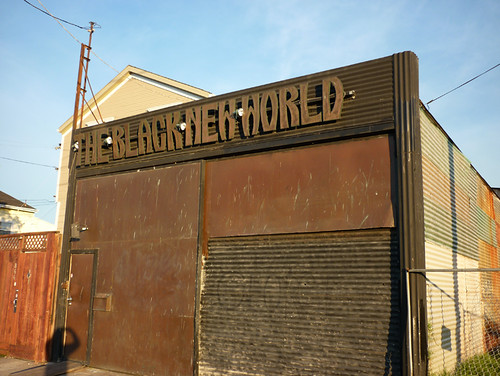
Looks like a really cool gathering place for artists to me. I know it’s not Starbucks, but we’re talking about a Cultural district here, right? Let’s take a look inside, shall we? (I did)
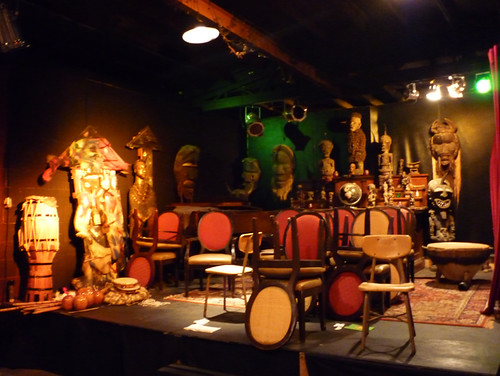
Seems perfectly suitable for events, and in fact has been host to a diverse Bay Area community of artists including Kev Choice, Rebirth Brass Band, Dwight Tribble, Opal Palmer Adisa, Umar Bin Hassan of The Last Poets, Ntozake Shange, Kahil El Zabar of the Ethnic Heritage Ensemble, David Murray, Emory Douglas, Boots Riley, Baba Zumbi, Githinji, Rudi Mwongozi, Collette Eloi, Afrikan Sciences, Hot 8 Brass Band, and many more. Why it’s not a building worthy of a seismic upgrade is beyond me. And I didn’t see a hole either. Did Robert Gammon bother to take a look inside?
Finally, we’ve come full circle, and we’re back to the source of all these misgivings, The Farm:
As for Village Bottoms Farms, it’s a gated vacant lot, and the only thing that appears to resemble a farm is a mid-size planter with some tomato vines in it.
Well, judging by the photo (credit: Chris Duffy) they have posted with the article I don’t even blame him for saying that:
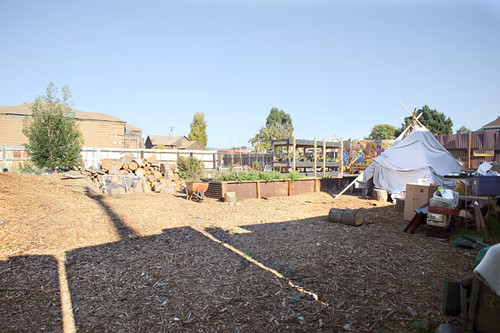
But as in life, photography, and farming, there is usually more than one perspective, and you usually find out more about a subject when you get closer to it. This is a photo I took a few weeks ago when I visited the farm:

Aside from the fact that, Yes, Mr. Gammon, Village Bottoms Farms probably would be further along had they got the grant, it is actually quite amazing how far it has come with just the volunteer sweat and labor from the community. Kirstin Miller describes what has happened since March:
After receiving zero funds for the farm from the CBDG board, we kept on working on the project anyway, eventually securing small grants from Kaiser Permanente and the Foundation for Sustainability and Innovation. To date, the farm compost system is up and running with the red wiggler worms getting nice and fat. The community has built the first aquaponics systems, they however need to get the greenhouse finished before they can add fish to the tank. Local businesses are supplying the resource streams for the compost: coffee grounds, brewery waste, sawdust and wood chips, food scraps. Community volunteers are there every day working on the project. Ecocity Builders and the Village Bottoms Neighborhood are jointly gearing up to apply to more funding sources to build out the prototype farm. The vision is to eventually expand farther down the street where one day a much larger urban farming enterprise could start providing more fresh and healthy food to the community while creating jobs and food security in the neighborhood.
Red wiggler worms, anyone?

I think you get the idea by now: A case has been made through the media against Marcel Diallo, who is accused of defaming Max Allstadt via a fraudulent email. Marcel Diallo says he did not write the email. Anyone in the community with knowledge of the password could have written it, including one of the many internet-savvy detractors of Mr. Diallo, who have made it no secret that they would like to see the entire Village Bottoms Neighborhood Association fail. As someone who firmly believes in the concept of innocent until proven guilty I cannot in good conscience pass judgment based on this article. While I absolutely sympathize with Mr. Allstadt and the agony this email must have caused him, it is going to be extremely hard to prove who wrote the email.
It seems that at the same time, in a parallel trial based on non sequitur arguments, misinformation and insinuation, a second case has been made, not only against Mr. Diallo and his character, but the legitimacy of the efforts by the entire Village Bottoms community to revitalize their neighborhood. That’s why I feel compelled to speak up, not only to offer an alternate perspective to the one-sided article, but to expose the depiction of Mr. Diallo as the poor, failing, greedy and scheming con man as the sham that it is.
As all of us who use computers and the internet have probably experienced at one point, it can get heated really fast and easy under the cover of anonymity. My personal antidote to this problem is to 1) never say anything online that I wouldn’t say in public, and 2) stay engaged in real life through positive interaction, so that any potential online defamation will never get the traction it seeks to get. I think all of the parties’ energy here would be much better spent being out in West Oakland communicating with each other in person and working toward getting as many farms off the ground as possible instead of holding media and internet trials that can only lead to further defamation and distrust. Everyone seems to share the common goal of building a sustainable, just, and safe community, so let’s log off and get to work.
peace & blessings,
Sven
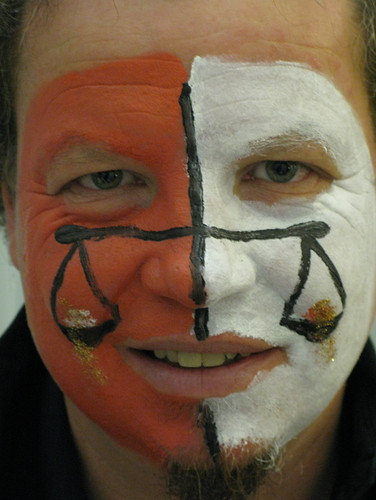



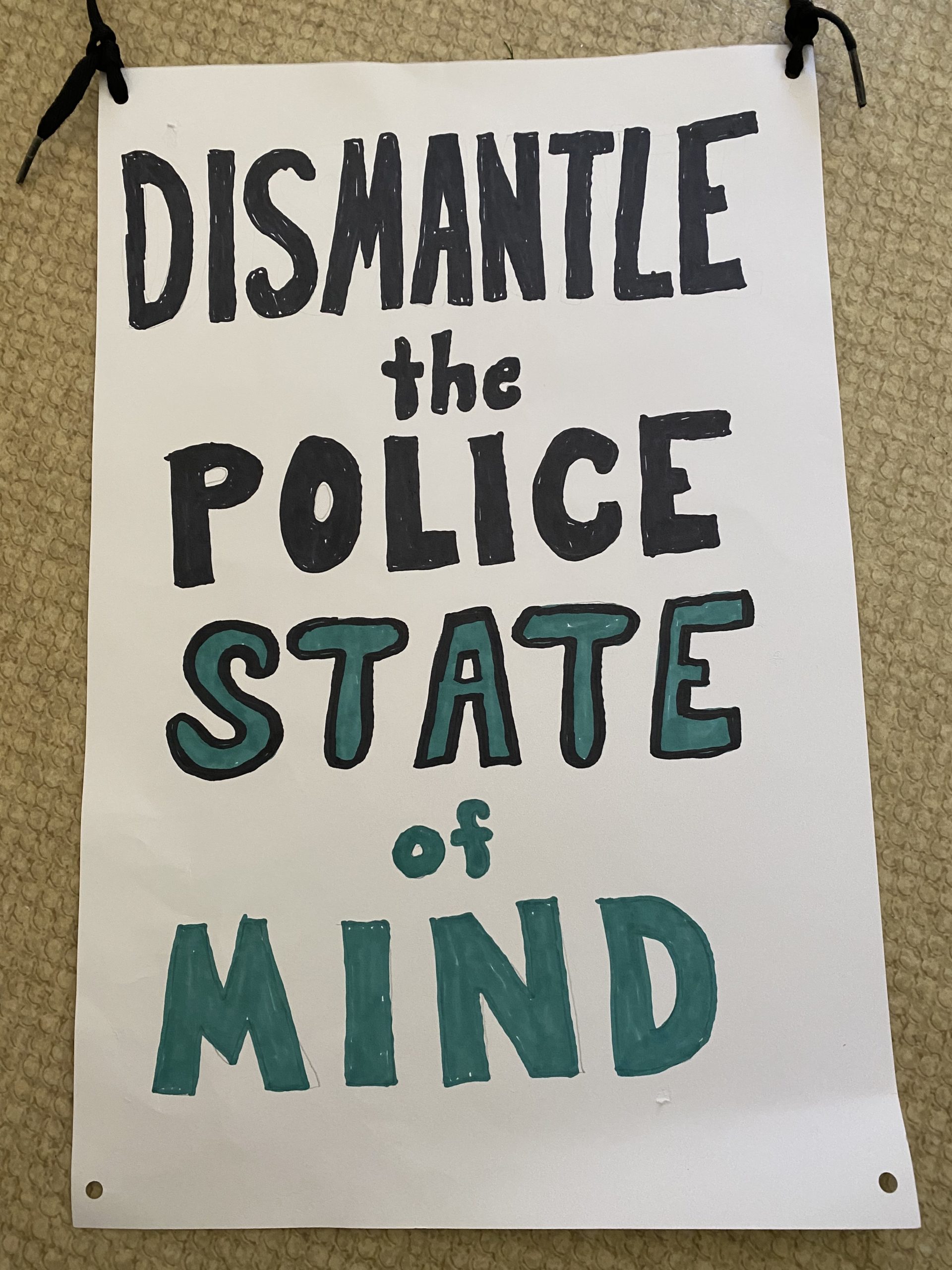




Wow.
I’m still reading, but just wanted to say that having the magazine’s article and Kristin’s writings in the same color has confused me. I am easily confused, but just wanted to let you know. Back to reading.
Pam
Okay, I’m done. You took an incredible amount of care to explain what was reported, the accusations and what you believe is happening. It takes courage to do this, Sven. Did you send this as a letter to the editor of the East Bay Express? I wonder if they would publish it? Probably not: You know what you’re talking about.
I felt such joy when I read your other Village Bottoms pieces. I thought, things are changing! The best part is the well-earned, legitimate involvement of African American citizens making their community better.
You know what this whole thing stinks of? A wealthy person sitting in a huge office on the top floor of a skyscraper, making plans for some large development. You know the story: We want it and we’ll do whatever it takes to get it. Maybe I’m wrong. I hope so.
For the Record: I was once the Operations Officer for a very large bank’s mortgage lending office and NO ONE read the papers they signed. They depended on the Loan Officers to explain the basics of the contract, then placing their initials at the bottom of each page. During my time, loan officers could not get approvals for loans that could affect the stability of the bank. Obviously, that changed after I left. But I am certain the people receiving these sub-prime loans did not read or understand their contracts and, also, that they did not understand what the specifics would mean in their futures. The people who made these loans KNEW what the likely outcome would be, but didn’t care because they were making big, big money.
Don’t even get me started–everything is set up for the wealthy and the educated. The fact that Marcel Diallo and the others who are working with him had the guts to even try to make these changes in their own neighborhood is a miracle unfolding and you are a part of it, Sven. A lot of people who tread on other people are very uncomfortable with miracles.
Pam, thanks so much for reading the whole thing. I did send a letter to the editor at the East Bay Express, as well as many others who were very displeased with the way they wrote about it. I sent a much shorter version of this, since obviously they wouldn’t print anything this long. We’ll see if any of the responses will get published.
I do think and hope that this is just a bump in the road. This community is very strong, very kind, and very resilient, and they will keep revitalizing their neighborhood and slowly but surely improving conditions for everyone. It’s ultimately not about Marcel or one email, and that’s the beauty of it. Adversity can actually be a gift, if you deal with it in an open way with an eye toward the high road.
Thanks for sharing your experience with the mortgage office too. A lot of the people who just do their job often don’t know what’s going on. All too often the people at the top get away with enriching themselves on the backs of those who do not know, have no power, and are just trying to get by. And often folks at the bottom of the chain end up fighting each other because there seems to be no connection to the decisions made in the towers.
Sven–did you notice that Gammon found it damming that the email was sent at 2:47 a.m. from a “sparsely populated area”. I guess being located in a 163 unit condominium complex counts as sparsely populated.
In Max’s response to the article:
“Mr. Gammon mentions that the email was created at 924 pine street at 2:47 am. The article did not mention that records show the email was sent from 924 Pine Street at 8:55 am. This suggests it took over six hours to compose the email. It also suggest that it may have been sent deliberately rather than impulsively.
It is important to point out that Comcast and Google NEVER said that the email came from the cafe.”
The Black Dot Cafe in it’s history has moved up and down Pine Street. A good wireless router could hit a block or two. Neither Google nor Comcast can possibly know that the email was sent from 924 Pine Street. They can only say ID the owner of the IP address.
But I wonder who DID send the email? Some possible suspects…
Ron Dellums…Because he can.
Rick Holiday…Because he will evict the Black Dot Cafe and bring in Starbucks.
The Flying Circus…Because they want to rise above West Oakland.
Archbishop Cordileone–Because there can only be one anarchist carpenter.
Chip Johnson–Because there can only be one source of dirt on West Oakland.
The Worms in VB Farms–because they want the real dirt.
It could have been any resident of the Lower Bottoms who knew about free wireless on Pine Street, who was angry with Max Allstadt’s blog, activism, running for office or ability to get a seat to decide the fate of Community Development Block Grants.
The bottom line is that West Oakland cannot afford petty turf wars or everyone loses.